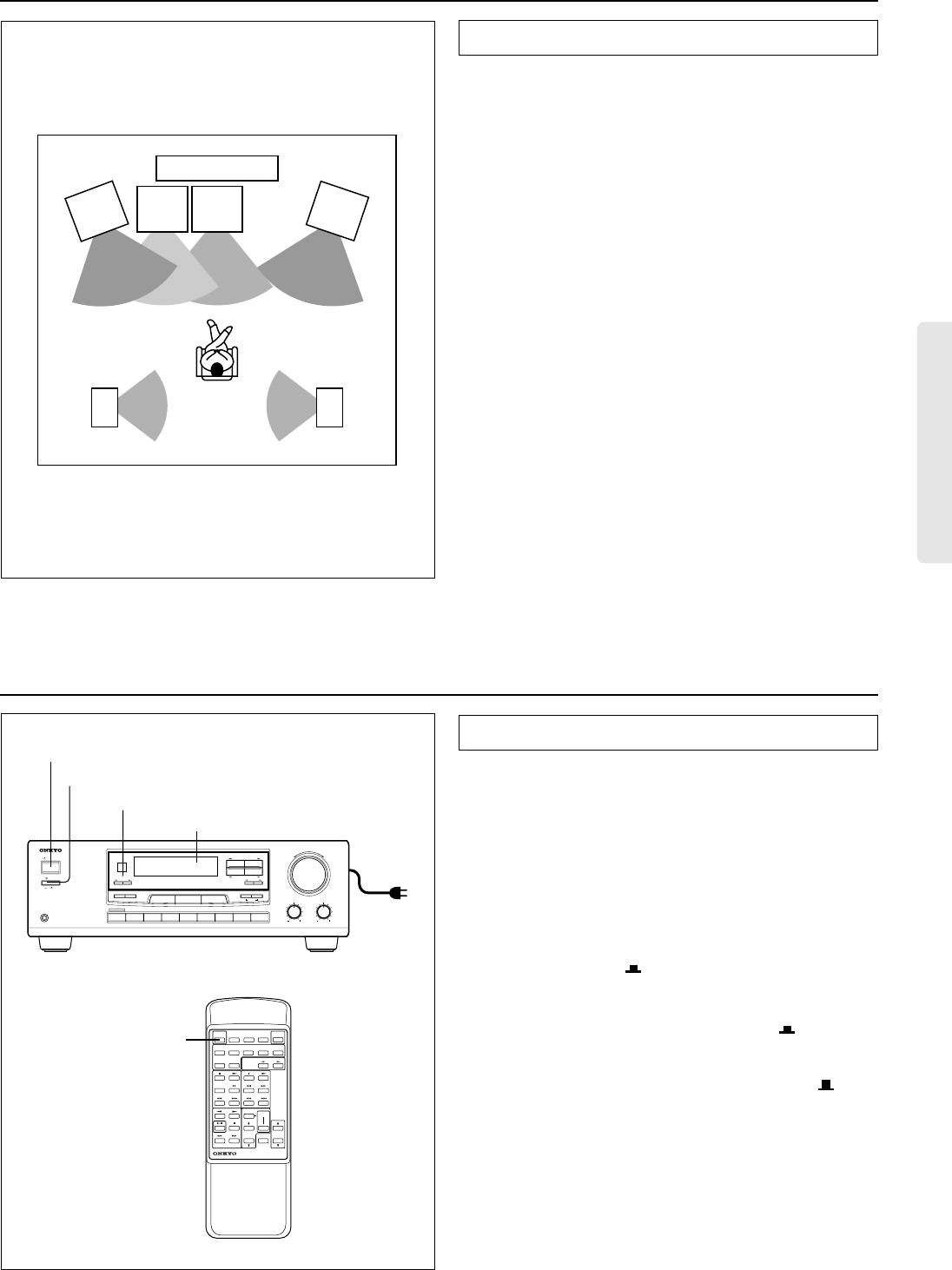
11
Positioning speakers
Speaker placement plays an important role in the reproduction of
Surround sound. The placement of the speakers varies depending
on the size of the room and the wall coverings used in the room.
The illustration shows an example of a layout for standard speaker
placement. Refer to this example when you position the speakers in
order to experience the best of Surround sound.
Standard speaker placement
For ideal Surround effects, all speakers should be installed. If a
center speaker or subwoofer is not connected, the sound from the
unused channel is properly distributed to the connected speakers in
order to produce the best Surround sound possible.
Front: The left, right, and center speakers should face the seated
listener and be placed at ear level. The center speaker produces a
richer sound image by enhancing the perception of the sound’s
source and movement.
Surround: Place the left and right Surround speakers 1 meter
(3 feet) above the listener’s ear level and facing toward the sides of
the room, making sure that the listener is within the speakers’ dis-
persion angle. These speakers produce the feel of a moving sound
while creating the sensation of being in the middle of the action.
Subwoofer: Install a subwoofer with a built-in power amplifier for
powerful bass sounds. The placement of the subwoofer does not
affect the final quality of the sound image too much, so you can
install it with the room layout in mind.
Refer to the speaker’s instruction manual for more details.
Positioning speakers
TV or Screen
Center
speaker
Surround
speaker
Right
Surround
speaker
Left
Listener
Sub-
woofer
speaker
Front
speaker
Left
Front
speaker
Right
Connecting the power
• Before you plug in the receiver, confirm that all connections
have been made properly.
• Turning on this receiver’s power may cause a momentary power
surge, which might interfere with other electrical equipment,
such as computers. If this happens, use a wall outlet on a differ-
ent circuit.
1. Plug the power cord into an AC wall outlet.
NOTE:
When you use the TX-DS484 for the first time:
When the TX-DS484 is shipped from the factory, the POWER
switch is set to ON ( ). Therefore, when you plug in the
power cord to the AC outlet, the Standby indicator lights up and
the unit enters Standby mode as described in Step 2.
2. Press the POWER switch to set it to the ON( ) position to
place the receiver in Standby mode.
The STANDBY indicator will light up.
Press the POWER switch again to set it to the OFF ( ) posi-
tion to turn off the power to the receiver.
3. Press the STANDBY/ON button or POWER button on the
remote controller to turn on the receiver. The display will
light up and the STANDBY indicator will be turned off.
If you press the STANDBY/ON button or POWER button on
the remote controller again, the receiver returns to Standby
mode.
• You cannot use the remote controller if the POWER switch on
the receiver is set to OFF.
Connecting the power
OFF
ON
POWER
STANDBY/ON
BASS
TREBLE
C D
PHONES
DIMMER
TX-DS484
AV RECEIVER
AMFMDVD PHONO
1VIDEO
2VIDEO
TI
CH
INPUTMUL
TAPE
STANDBY
TUNING
CLEAR
MEMORY
FM
MODE
SPEAKERSA B LATE NIGHTSURROUND MODE
PARAMETER CONTROLLER
PARAMETER SELECTOR
PRESET
U
P
MASTER VOLUME
D
O
W
N
2. POWER switch
3. STANDBY/ON button
STANDBY indicator
Display
To wall
outlet
1.
POWER
SLEEP DIMMER
SUR
MODE
VIDEO-1 VIDEO-2
TAPEDVD C D
C D DVD
TUNER
TUNER
PHONO
INPUT SELECTOR
DISC
TAPE
VOLUME
LEVEL
CH SEL
PRESET
MUTING
TEST
TONE
MULTI-CH
INPUT
REMOTE CONTROLLER
RC-427S
3. POWER button


















